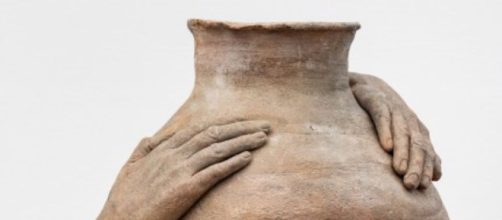What is sculpture? Silly question, right? Not if you’re talking about the contemporary variety. The art form has morphed from its figurative, three-dimensional self into – well, it’s hard to say what, exactly.
Where’s the rest of me?
Consider this year’s Nasher Prize of $100,000 for a sculpture by Senga Nengudi titled R.S.V.P. which is made of stretched pantyhose.
Not a figure in sight, just some nylon hose stretched thin as a wire between two points like a clothesline with what could be construed as legs attached standing below.
How you see this work is of little consequence.
The Nasher Prize honors “a living artist who elevates the understanding of sculpture and its possibilities.” See? The possibilities are the point.
This is probably why Art in America magazine’s current issue asks some curators the “what is sculpture” question. As you can tell by their responses, defining this art form is fleeting.
Karen Lemmey, curator of sculpture at the Smithsonian American Art Museum notes that the morphing (my word; she calls it manipulation of form) started in the last century.
That set me to think back to the 1970s, when Victor Spinski ceramics came in the form of a three-dimensional replica to scale of actual trash can he called “Covered Pail.”
But what Spinsky did doesn’t fit in with the way that Lemmey sees sculpture today.
She told Art in America that the latter-day art form pays a mind to the instability of the art form’s history: “A sculpture’s third dimension can be barely measurable or even just implied...”
Well, if all that’s needed to fit the classification of sculpture is “barely measurable” three dimensions, then some of Rembrandt’s portraits are sculptures.
Close up, they look to be made with a bricklayer’s trowel, which gives them that extra dimension.
Don’t take my word for it. The 17th-century historian Arnold Houbraken has written that Rembrandt sometimes painted portraits with pigment applied so heavily that you could lift it from the floor by the nose in the portrait.
According to Houbraken’s description of Rembrandt’s work process, immediately after a portrait had dried, he repainted it with enough pigment to amount to more than half the thickness of a finger!
That would qualify as a bas-relief – a longtime form of sculpture – in that the image is physically projected from the surface of the canvas. I see little difference between a thickly layered Rembrandt portrait painting and, say, the 16th-century sculptor Benvenuto Cellini’s low relief medal likeness of the French king, Francis I.
In the movies
And if you think classing Rembrandt’s portrait paintings as a sculpture is questionable, check Lucy Raven’s exhibit at Dia Art Foundation, which is known for testing sculpture’s limits. Raven showed a 45-minute film “Ready Mix” that followed the making of ready-mix concrete from liquid minerals. See? No sculpture. Just a film about it.
Alexis Lowry, curator at Dia Art Foundation, answered Art in America’s question by citing Raven’s answer when asked how she sees her movie as sculpture.
Forming and deforming fits the mold, the artist said.
Lowry was fine with that: “What appeals to me about her answer is her reflexive understanding of form...not as something fixed, but rather something malleable, unstable even.” Non-existent, too, no?
Art in America’s “what-is-sculpture” story doesn’t end here, but I’m ready to end it with this thought. If the concept of sculpture point to how unstable form is, we’re liable to end up with a show of artists’ statements without a sculpture anywhere to be seen.


